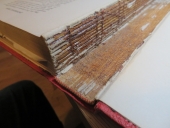Oh yay! A topic I actually know something about! My day job is as a rare books librarian, and while working on my MLIS degree, my student job was in a library conservation lab repairing books very much like this one. That said, I am *not* a trained conservator, and that student job was 12+ years ago, so please apply your own good judgment to any or all of the following suggestions.
As other posters have already said, the first thing you need to do is decide what type of repair you want and what your budget is in terms of time and money. Do you want something cheap and easy? Or something that will last for several decades?
"Archival" tape will bring the book back to a usable state with a minimum of effort and expense, but will eventually cause damage to it. That damage will happen much more slowly than if you used normal tape, but with any kind of tape, the adhesive will eventually fail and in the meantime the tape will make the paper stiffer, with a hard edge where the tape ends. The paper will crease and eventually tear along that hard edge of the tape. That may take a decade or two, which may be good enough for your purposes, but if you're really talking about "archival" repair, you're thinking in terms of lasting 50-100 years or more. (I put "archival" in quotes because there is no industry standard for what makes a product or a process archival. More specific terms to look for on "archival" products are acid-free, lignin-free, pH-neutral, or in some cases pH-buffered.)
If you opt for a repair that involves glue, as Pearl Sutton said earlier, you want something that will stay flexible over time. Ideally, it will also be pH neutral. In the conservation lab, we used PVA. If you can't find any locally, libraries tend to order from suppliers like University Products, Gaylord, Demco, and Hollinger Metal Edge (in the USA) and Gresswell and PEL (in the UK).
If you're reasonably crafty, you could do a hinge repair something like what's shown in this video:
https://www.youtube.com/watch?v=9O5XF91kDC8
There are, of course, much more involved repairs that could be done, but this seems like it would be relatively sturdy and requires a minimum of special tools and equipment. The one modification/addition I might make is to tear a narrow strip of Japanese paper (which has longer fibers than Western-style papers and leaves a very feathered edge when torn) and using it to reinforce the repair on the inside of the book and cover any gap that may show where the cloth hinge has been inserted. To attach the strip of paper, I would use something like a wheat or rice starch paste instead of PVA. To do this, you would follow a process very much like what's shown in this video from about the 3:00 mark onward, except attaching the strip of paper to the pages that are still attached to the book, instead of loose:
https://www.youtube.com/watch?v=QN8vh-i2Y4Q
The feathered edge of the torn Japanese paper alleviates the problem of the pages cracking along the hard edge of the repair, like with archival tape. A starch paste won't be as strong as PVA, but that can sometimes be a good thing, because it's better for the adhesive to fail than for the adhesive to be so strong that it causes other parts of the book to break. Unlike PVA, a repair done with starch paste can also be removed by carefully rehydrating the paste.
To tear a neat strip of Japanese paper, you need to weaken the paper in a straight line somehow. For a very feathered tear, you can use a water brush (or a narrow paintbrush and some water) to wet the paper in a neat line along a straight edge and then gently pull the paper apart along the line, like in this video:
https://www.youtube.com/watch?v=QUqkPlKo3EU. Alternatively, you can fold and crease the paper and then tear it carefully along the fold. Or you can use a bone folder or the blunt back edge of your knife to score the paper and then tear along the scored line. These options tend to cut at least some of the fibers though, resulting in a less feathered edge.
If you want to replace the missing pages, you can try to track down another copy via interlibrary loan (you can search for library copies worldwide via www.worldcat.org) and request photocopies or scans of the missing pages. Then you can trim the copied pages to the same size as the rest of the book and then tip them in. (video tutorial here:
https://www.youtube.com/watch?v=xvTK8tUCcmA)
I hope this helps!



